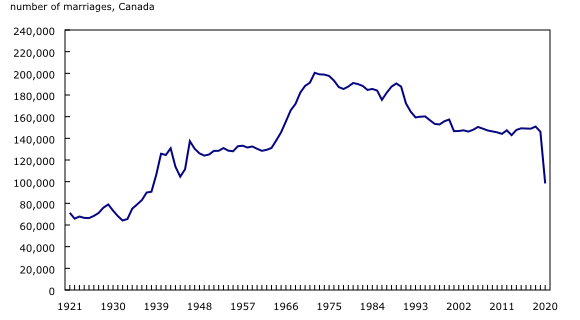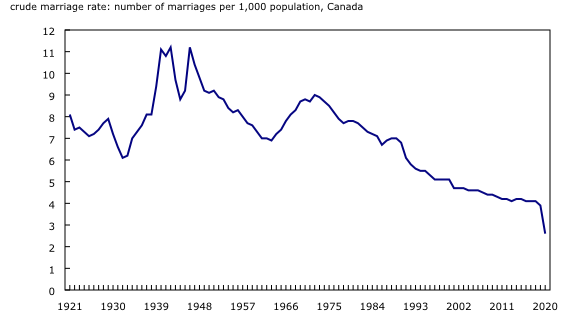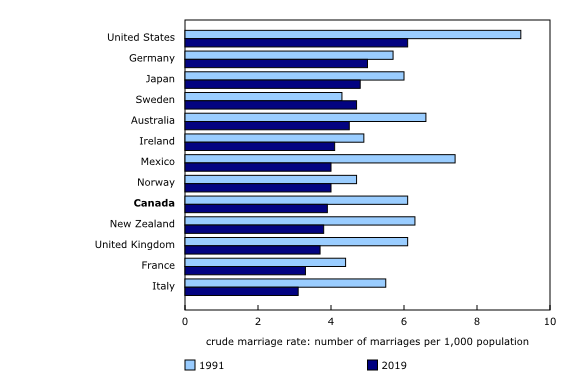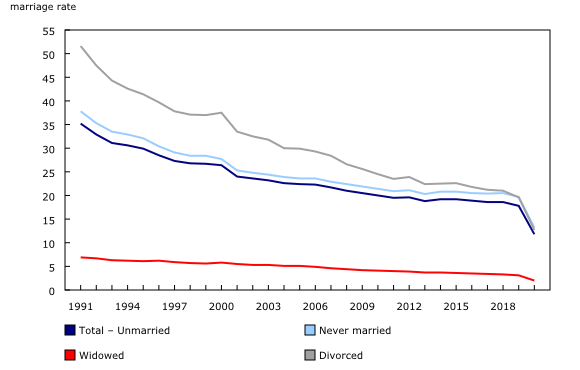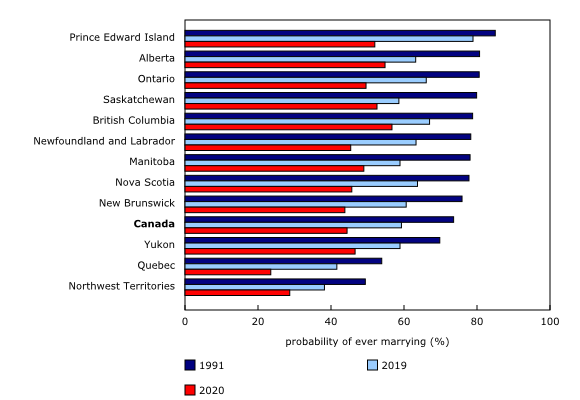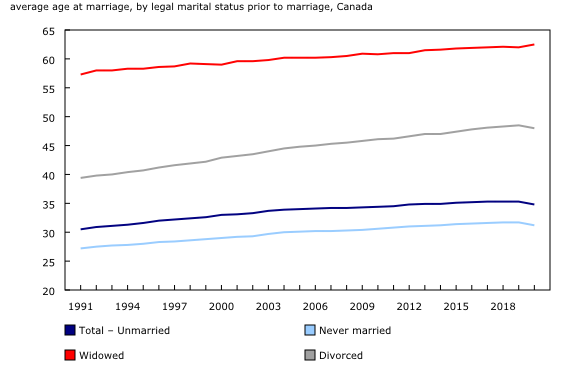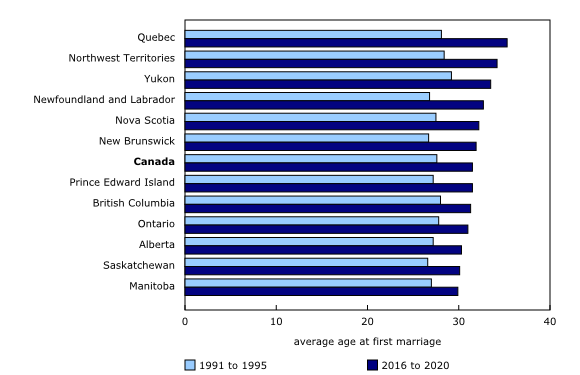"I don't": Historic decline in new marriages during the first year of the pandemic
Released: 2022-11-14
The drop in new marriages from 2019 to 2020 is the largest on record
Today, Statistics Canada releases new information on marriages with the collaboration of the vital statistics registrars of each province and territory.
There were 98,355 marriages registered in Canada in 2020, the lowest annual number recorded since 1938 when the population was much smaller than it is today.
The number of marriages registered in 2020 was one-third lower (-33%) than in 2019 (146,121). This is the largest annual decline observed since the vital statistics data on marriages were first compiled in 1921.
This historic drop in the number of marriages in 2020 occurred during the first year of the COVID-19 pandemic. Across the provinces and territories, public health measures aimed at limiting the spread of the virus were implemented beginning in mid-March of that year, including stay-at-home requirements, restrictions on gatherings (including in places of worship), closure of non-essential retail and barriers to travel. Given the celebratory and often public nature of marriages, these measures—combined with participants' desire to avoid infection—likely disrupted the wedding plans of many couples.
The year 2020 was also marked by a record drop in the number of divorces (-25%), although it was relatively smaller than the drop in the number of marriages. The pandemic-related slowdowns in court proceedings were likely the main factor driving the decline in divorces that year.
In 2020, all provinces and territories witnessed a drop in marriages, but to varying degrees. Among the provinces, the decline was largest in Quebec (-49%) and smallest in Saskatchewan (-18%). Generally, the decrease was stronger in Ontario and in the provinces to the east of it and weaker in the Prairies and British Columbia. These differences could be linked to variation in the stringency of provincial and territorial public health measures. For instance, Quebec and the Atlantic provinces had more stringent responses during the first months of the pandemic.
The 2020 decrease in marriages was of a similar magnitude across all legal marital statuses—that is, whether spouses were never married, divorced or widowed before the new marriage was registered. The decline occurred in all age groups, but was relatively stronger for people aged 40 to 65.
Marriage statistics do not reflect all new couple relationships
The marriage of a couple establishes a set of mutual legal rights and obligations between spouses. Provincial and territorial vital statistic registrars have a mandate to maintain a record of all marriages registered within their jurisdiction.
By contrast, the formation of a common-law union, which has fewer legal effects, does not typically involve any legal agreement or official paperwork and therefore leaves few administrative traces that could be used to produce annual, robust and accurate official statistics.
The share of all co-residing couples that were living common law, as opposed to being married, has increased steadily over time, from 6% in 1981 to 23% in 2021. Additionally, a growing share of adults live apart from their romantic partners—particularly young adults. While marriages still account for the majority of couples today, they represent only a part—and a shrinking part—of all romantic relationships that are formed in a given year. This is particularly true in Quebec and the territories where common-law unions are more prevalent.
Although marriage statistics do not reflect all union formations, they still provide valuable information on the state of marriage as a social and legal institution in Canada.
The 2017 General Social Survey – Family provides the most recent survey-based information on the formation of common-law couples as well as on couples who live apart.
The 2021 Census of Population recently provided new information on the characteristics of married and common-law couples in Canada, including trends at more detailed levels of geography. As part of this release, information on the gender diversity status of couples in Canada has become available for the first time.
The 2020 drop follows a five-decade-long decline in the crude marriage rate
Over the last century, the crude marriage rate (CMR) —the number of marriages per 1,000 population—has fluctuated along with major economic or political events and social changes.
In the 1920s, marriage occurred relatively late (at an average age of 25.5 years for women and 29.9 years for men in 1921) and over 1 in 10 adults never married during their lifetime. In the early 1930s, the Great Depression drove marriage rates to unprecedentedly low levels. However, along with the economy, marriage rates had recovered by the end of the decade when the Second World War broke out.
The catching up of marriages that could not take place because of the Great Depression, as well as the prospect of overseas conscription—which might have encouraged many young men to marry—led to record-high marriage rates in the early 1940s. The end of the war in 1945 and the return of soldiers to Canada created conditions for a second marriage boom in the second half of the 1940s.
Though the CMR declined in the 1950s, it remained higher than in the pre-war period as more people married and did so at increasingly younger ages on average. This new model of more universal and younger marriage was maintained throughout the 1960s and the number of marriages kept rising, bolstered by the large cohorts of the baby boom who gradually reached marriageable ages.
After peaking in 1972, the CMR began a pattern of steady decline that continues five decades later. The ageing of the population, the growing popularity of common-law unions and the increase of the average age at marriage are among the main drivers of this decline.
By the beginning of the 1990s, the CMR had dipped below the levels recorded during the Great Depression. In 2019, it had reached its lowest level on record (3.9 marriages per 1,000 population), but with the 2020 drop, the CMR fell to an even lower level (2.6 marriages per 1,000 population).
Marriage levels in Canada in line with other G7 countries
This long-term decline in marriage rates is not restricted to Canada—it can be seen in countries across the globe.
For instance, from 1991 to 2019, marriage rates in Canada evolved in parallel to those of countries like the United Kingdom, Australia and New Zealand. While marriage rates were higher in the United States, the relative decline during this period was also of a similar magnitude to that seen in Canada.
Just prior to the pandemic, in 2019, the CMR in Canada was close to the average among G7 countries. However, the 33% drop in marriages from 2019 to 2020 in Canada was relatively large. It was comparable to that observed in France (-34%), smaller than in Italy (-47%) but greater than in Germany (-10%), Japan (-12%) and the United States (-17%).
New today!
Today, Statistics Canada unveils the following series of new marriage data tables:
• Number of marriages and nuptiality indicators (39-10-0055-01)
• Mean age and median age at marriage, by legal marital status (39-10-0056-01)
• Number of persons who married in a given year and marriage rate per 1,000 unmarried persons, by legal marital status and age group (39-10-0057-01).
The following divorce data tables have also been updated because the number of marriages is used in the computation of some divorce indicators:
• Number of divorces and divorce indicators (39-10-0051-01)
• Number of divorces and divorce rate per 1,000 marriages, by duration of marriage (39-10-0054-01).
Fewer remarriages
Most people who get married are doing so for the first time.
Among newly-married individuals, the share that had previously been married decreased over the last couple of decades, from 25% in 2000 to 20% in 2020. This is a reversal from an earlier trend: After the liberalization of divorce in 1968, there was an increase in the number of people entering a second or third marriage after divorcing their previous spouse. The current decline in the share of people remarrying can be linked to the increasing popularity of common-law unions after a divorce, especially among seniors.
This trend can also be seen when analyzing marriage rates by marital status. In 1991, 38 out of every 1,000 never-married persons aged 15 and older got married; in 2019, the rate was 20 per 1,000. The decline was much greater among divorced persons, with the rate falling from 52 per 1,000 divorced persons to 20 per 1,000 over the same period.
The probability of ever marrying was lowest in the Northwest Territories and Quebec, but has decreased fastest in the Prairies
The probability of ever marrying is a summary indicator of nuptiality that can be interpreted as the percentage of persons who would enter a first marriage during their lifetime, based on the age-specific marriage rates of a given year. The probability of ever marrying is especially useful for comparisons because, in contrast to the CMR, it accounts for differences in the age structure of the unmarried population across time and place.
According to age-specific marriage rates in effect in Canada from the 1940s to the beginning of the 1970s, more than 95% of persons would have ever married. By contrast, if marriage rates were kept constant at levels observed in 2020 (the first year of the pandemic), 44% of persons would do so.
Even when excluding the special case of 2020, the probability of ever marrying has been decreasing steadily over the last decades, from 74% in 1991 to 59% in 2019. While a decline has been observed in all provinces and territories over the same period, there remain large differences across regions.
As was the case in 1991, the probability of ever marrying in 2019 was lowest in the Northwest Territories (38%) and Quebec (42%), and highest in Prince Edward Island (79%). The decline in the probability of ever marrying was the strongest in the Prairies over that period. In particular, Saskatchewan (80%) and Manitoba (78%) went from having some of the highest probabilities of ever marrying in 1991, to some of the lowest in 2019 (59% in both provinces).
Average age at marriage has increased in all provinces and territories
The rise in the average age at marriage is a strong and long-lasting trend that started after 1968, when it had reached a low of 25.6 years. This rise, which started the year the Divorce Law came into force, was initially related to the growing number of remarriages occurring later in life. In more recent years, the growing popularity of common-law unions, sometimes formed as a prelude to marriage, has become the main driver of the postponement of marriage. By 1983, the average age at marriage had surpassed the previous record set in the 1920s and has reached a new high every year since then. In 2019, it was 35.3 years.
The slight decrease in the average age at marriage in 2020 (to 34.8 years) reflects the fact that the decline in number of marriages that year was relatively stronger among persons aged 40 and older. While this decrease appears to be related to the pandemic, it remains to be seen whether the average age at marriage will resume its rise in coming years.
While the average age at marriage has increased everywhere in Canada, it did so at different paces throughout the country. Over time, patterns in the age at marriage have become increasingly varied across the provinces and territories.
During the period from 1991 to 1995, the gap between the lowest average age at first marriage (Saskatchewan, at 26.6) and the highest (Yukon, at 29.2) was 2.6 years. In the period from 2016 to 2020, the gap was more than twice as wide at 5.4 years, with Manitoba having the lowest average age (29.9) and Quebec having the highest (35.3). This increasing regional variation in the age at marriage is related to common-law unions growing in popularity at different paces across the country, with Quebec and the territories having the highest proportions of couples living common law and Ontario and the Prairies having the lowest, according to the 2021 Census.
Looking ahead
Preliminary data released by several provincial and territorial vital statistics registrars (Prince Edward Island, Quebec [in French only], Ontario, Saskatchewan, Alberta, British Columbia and Yukon) show that the number of marriages in 2021 was higher than in 2020, but still lower than in the pre-pandemic period. According to these estimates, the number of marriages in 2021 was still between 3% (Yukon) and 34% (Quebec) lower than in 2019. With gathering restrictions having largely been lifted in all provinces and territories by the spring of 2022, this year could see a catching-up of the marriages that were postponed in 2020 and 2021.
Note to readers
Today, Statistics Canada is releasing new data on marriages for the years 2009 to 2020. Data for 2019 and 2020 are considered preliminary. Revised data for the years 1991 to 2008 are also being released—the number of marriages remains the same as previously published, but marriage rates have been updated by using current population estimates in their computation.
Data sources
These statistics are from the Canadian Vital Statistics – Marriage Database, a program that processes information collected by the vital statistics registrar of each province and territory. The registrars maintain a record of all births, stillbirths, deaths and marriages occurring in their area. Data from the Demographic Estimates Program are also used in the computation of marriage rates.
Data released today may differ from data previously published by Statistics Canada or by individual provinces and territories. The number of events in vital statistics registries can fluctuate during registration collection and with revisions. Data presented in tables therefore represent a snapshot of databases at the time of data extraction. Different treatment of missing information as well as the use of different sets of population estimates for computing rates could also lead to discrepancies.
Place of occurrence
Marriage statistics are produced by place of occurrence. Provincial and territorial registrars record all marriages that occur in their jurisdiction whether the usual place of residence of spouses is this province or territory, another province or territory, or another country. This could lead to an overestimation of marriage rates because non-resident spouses are counted in the numerator but are not part of the population in the denominator. Marriages of non-residents may be more numerous in some provinces than in others. By contrast, the marriages of Canadian residents that are registered in other countries are not included in statistics and this could lead to an underestimation of marriage rates.
Gender or sex of persons who marry and gender composition of couples
Statistics published today include all people who married in a given year, regardless of their gender or sex, and all marriages, regardless of the gender composition of couples. Data for the years following 2008 are not released separately by gender or sex at either the individual or couple level because some provinces and territories do not currently record this information on their marriage registration form. The information is nevertheless released by some of the other provincial and territorial registrars that do collect it.
Recently released data from the 2021 Census measure the gender diversity of the population as well as the number of people living in various types of couples, including different-gender and same-gender couples as well as couples that include at least one transgender person or one non-binary person.
Contact information
For more information, or to enquire about the concepts, methods or data quality of this release, contact us (toll-free 1-800-263-1136; 514-283-8300; infostats@statcan.gc.ca) or Media Relations (statcan.mediahotline-ligneinfomedias.statcan@statcan.gc.ca).
- Date modified:

